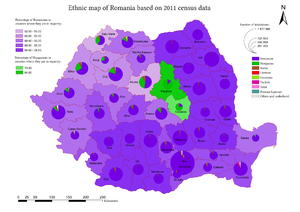
Back المجريون في رومانيا Arabic المجريين فى رومانيا ARZ Унгарци в Румъния Bulgarian Hongaresos de Romania Catalan Maďaři v Rumunsku Czech Magyaren in Rumänien German Hungaroj en Rumanio Esperanto Húngaros de Rumania Spanish Rumeenia ungarlased Estonian Hongrois de Roumanie French
Romániai magyarok | |
|---|---|
| Total population | |
| 1,002,151[1] | |
| Regions with significant populations | |
| 232,157 (79.51%) | |
| 133,444 (66.71%) | |
| 165,014 (31.84%) | |
| 93,491 (28.27%) | |
| 112,387 (20.39%) | |
| 78,455 (11.55%) | |
| Languages | |
| Primarily Hungarian and Romanian | |
| Religion | |
| Calvinism (45.3%), Roman Catholicism (40.4%), Unitarianism (4.6%) | |
| Related ethnic groups | |
| Hungarian diaspora as well as Hungarians in Serbia and Hungarians in Slovakia | |





The Hungarian minority of Romania (Hungarian: romániai magyarok, pronounced [ˈromaːnijɒji ˈmɒɟɒrok]; Romanian: maghiarii din România) is the largest ethnic minority in Romania. As per the 2021 Romanian census, 1,002,151 people (6% of respondents) declared themselves Hungarian, while 1,038,806 people (6.3% of respondents) stated that Hungarian was their mother tongue.[1]
Most ethnic Hungarians of Romania live in areas that were parts of Hungary before the Treaty of Trianon of 1920. Encompassed in a region known as Transylvania, the most prominent of these areas is known generally as Székely Land (Romanian: Ținutul Secuiesc; Hungarian: Székelyföld), where Hungarians comprise the majority of the population.[2] Transylvania, in the larger sense, also includes the historic regions of Banat, Crișana and Maramureș. There are forty-one counties of Romania; Hungarians form a large majority of the population in the counties of Harghita (85.21%) and Covasna (73.74%), and a large percentage in Mureș (38.09%), Satu Mare (34.65%), Bihor (25.27%), Sălaj (23.35%), and Cluj (15.93%) counties.
There also is a community of Hungarians living mostly in Moldavia, known as the Csángós. These live in the so-called region of Csángó Land in Moldavia but also in parts of Transylvania and in a village of Northern Dobruja known as Oituz. In addition, sparse populations of Székelys are to be found across southern Bukovina, inhabiting several villages and communes in Suceava County. Aside from the aforementioned historical regions of Romania, Bucharest was also home in the past and still is to a sizable Hungarian-Romanian community.
- ^ a b Széchely, István (3 January 2023). "Mintha városok ürültek volna ki" [As if cities had been emptied]. Székelyhon (in Hungarian). Retrieved 24 January 2023.
- ^ "Comunicat de presă privind rezultatele definitive ale Recensământului Populației și Locuințelor – 2011" (PDF). Recensamantromania.ro (in Romanian). Archived from the original (PDF) on 17 July 2013. Retrieved 10 July 2013.